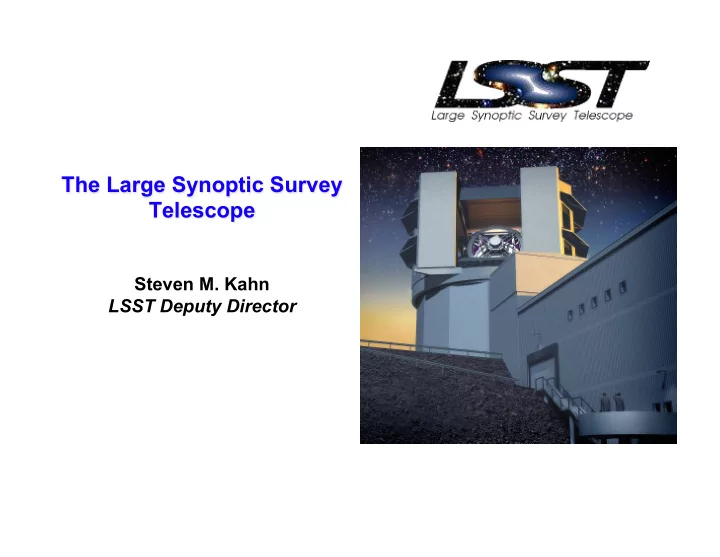

The Large Synoptic Survey Telescope Steven M. Kahn LSST Deputy Director
What is the LSST? • The LSST will be a large, wide-field ground-based telescope designed to provide time-lapse digital imaging of faint astronomical objects across the entire visible sky every few nights. • LSST will enable a wide variety of complementary scientific investigations, utilizing a common database. These range from searches for small bodies in the solar system to precision astrometry of the outer regions of the galaxy to systematic monitoring for transient phenomena in the optical sky. • Of particular interest for cosmology and fundamental physics, LSST will provide strong constraints on models of dark matter and dark energy through statistical studies of the shapes and distributions of faint galaxies at moderate to high redshift, and the detections of large numbers of Type Ia supernovae.
Summary of High Level Requirements Survey Property Performance Main Survey Area 18000 sq. deg. Total visits per sky patch 825 Filter set 6 filters (ugrizy) from 320-1050nm Single visit 2 x 15 second exposures Single Visit Limiting u = 23.9; g = 25.0; r = 24.7; I = 24.0; z = 23.3; Magnitude y = 22.1 Photometric calibration < 2% absolute, < 0.5% repeatability & colors Median delivered image ~ 0.7 arcsec. FWHM quality Transient processing latency < 60 sec after last visit exposure Data release Full reprocessing of survey data annually
LSST Will be Sited in Central Chile Central Chile Location Map La Serena La Serena airport 5 0 k m p a v e d port h i g LSST h w a y Base Facility Coquimbo Puclaro Vicuña dam & tunnel y a w CTIO AURA h g i property H n (Totoral) a c i r e Gemini & SOAR m A N - n a LSST SITE P 0 10 20 km
The dome and facility design minimizes dome seeing. After ~4,000 kg of explosives and ~12,500 m 3 of rock removal, Stage I of the El Peñón summit leveling is completed.
The ¡modified ¡Paul-‑Baker ¡op3cal ¡design ¡provides ¡ a ¡large ¡field ¡of ¡view ¡with ¡high ¡image ¡quality. ¡
The telescope mount has been optimized for fast slew and settle. • Points to new positions in the sky every 37 seconds • Tracks during exposures and slews 3.5° to adjacent fields in ~ 4 seconds
The ¡3.2 ¡billion ¡pixel ¡camera ¡enables ¡a ¡9.6 ¡ square ¡degree ¡field ¡in ¡a ¡3ght ¡enclosure. ¡ Focal plane Utility Trunk— houses support electronics and utilities Cryostat—contains focal plane & its electronics L3 Lens 1.65 Filter m (5 ’ -5 ” L2 Lens ) L1 Lens
Project timeline enables “first light” in 2019. DOE CD-3a: authorization for long- lead procurement NSF Final Design Review
Cosmic Shear Tomography
Galaxy Auto and Cross Power Spectra with Baryon Acoustic Oscillations
Type 1A Supernova Lightcurves Main Survey Deep Drilling Fields
Separate and Joint Constraints on the Dark Energy Equation of State
An ¡high ¡fidelity ¡photon ¡by ¡photon ¡simulator ¡enables ¡ detailed ¡quan3ta3ve ¡inves3ga3ons ¡ ¡of ¡image ¡systema3cs. ¡ ¡ ImSim Description 14
Simulating Ellipticity Contributions from the Atmosphere CFHT Data Simulation 15
The Effect of Non-Stochastic Optics and Focal Plane Perturbations for LSST 16
Quantitative Contributions to Ellipticity and Ellipticity Correlation for LSST 17
Estimates of Residual Spurious Shear Correlation After PSF Correction 18
Estimation of n eff for LSST Survey 19
Euclid Synergy With LSST • Euclid performs NIR band photometry in three colors (YJH), and visible band imaging over a broad spectral range. To determine photometric redshifts for the galaxies it will use in its weak lensing and other cosmological investigations, Euclid requires multicolor visible band photometry in narrower filter bands. This is planned to be obtained from the ground, using complementary facilities. LSST will be the premier facility to provide such measurements in the southern hemisphere. • LSST and Euclid each cover 20,000 square degrees of sky. The overlap area is ~ 11,000 square degrees. LSST will measure the sizes and shapes ~ 4 billion galaxies. We estimate that at least 1 billion will have measurable NIR colors from Euclid. • While the combined ground-based visible and space-based NIR photometry is essential for Euclid, it is also useful for LSST. The use of YJH photometry from Euclid does yield a modest but significant improvement in photo-z determination over what LSST can provide alone with its 6-color photometry.
Fraction of LSST “Gold Sample” Galaxies Detectable by Euclid
Photo-Z From LSST: With and Without Euclid
Synergy With Spectroscopic Facilities: Photo-z calibration • Estimated need 20k-30k spectra for conventional training/calibration; spectroscopic samples are >30% incomplete for 10x brighter objects today, so such samples may not solve all problems – PFS-like instrument (several thousand spectra over wide area on 8m telescope) is ~optimal for this – Could deal with incomplete training sets via trimming science samples or improved understanding of astrophysics • Alternatively, ~50k total objects over ~1000 deg 2 sufficient to meet LSST calibration specs with cross-correlations, if span LSST redshift range • MS-DESI galaxies + QSO's would provide a more than sufficient sample ; need spectroscopy of only brightest objects for cross- correlations
Summary • The LSST will be a world-leading facility for astronomy and cosmology. A single database will enable a large array of diverse scientific investigations. The project has broad support in the astronomy community, and it is therefore a key component of NSF ’ s long-term plan for the field. • LSST will measure properties of dark energy via weak lensing, baryon oscillations, Type 1a supernovae, and measurements of clusters of galaxies. It will test models of dark matter through strong lensing. No other existing or proposed ground-based facility has comparable scientific reach. • The synergy in technical and scientific expertise between the astronomy and HEP communities will be essential to the project ’ s success. • A detailed initial design is in place for all major components of the system. With appropriate funding from NSF and DOE, the project is on-track to achieve first light in 2019.
Recommend
More recommend